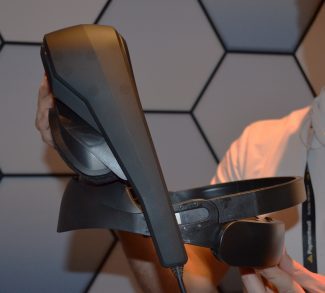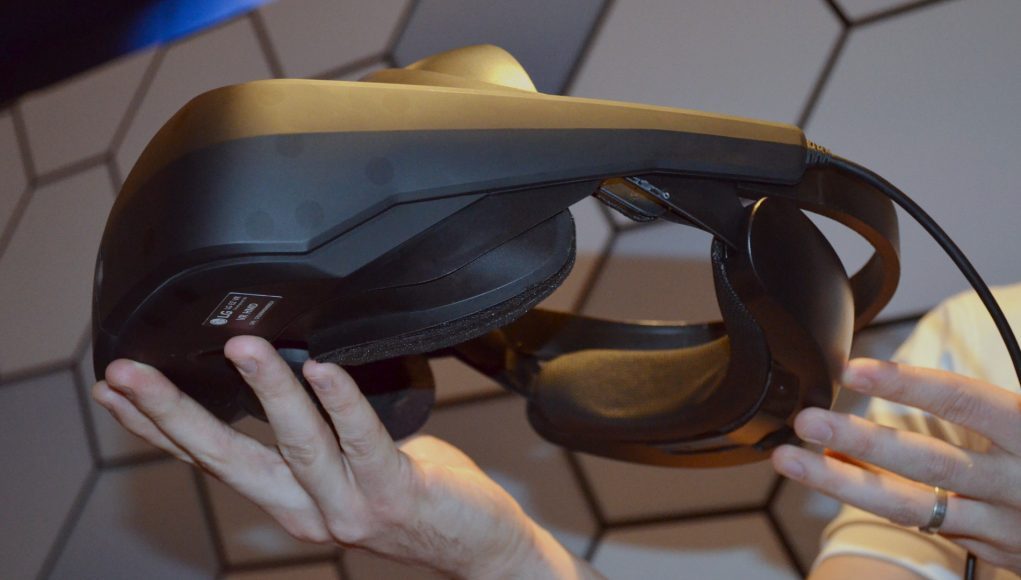Visual Performance

Through the lenses we see start to see more significant changes from the Vive. Getting the lenses as close to your eyes as possible results in the widest field of view (which felt on par with the Vive), and I found there to be no light leak at all once the display enclosure was pushed near to my face, though the nose-flap felt like it had some pointy edges and could be more comfortable.
The LG VR headset is not using Fresnel lenses, unlike the Vive and Rift. That means there’s no ‘light-ray’ artifacts, which are especially bothersome in high contrast scenes, though it does seem that there may be a tradeoff in the size of the focus ‘sweet-spot’; I noticed when turning my eyes away from the center of the lens that there was a fair amount of blur, perhaps a bit more than on the Rift and Vive.
As a display maker, LG is naturally supplying the OLED display in the headset. As a single panel (instead of one panel per-eye with the Rift and Vive), it sounds as though the company has pulled one of their smartphone panels for use in the headset, though people involved in the project say that they are doing some special things with the display to make it better for VR (but didn’t go into detail).
Through the lenses the improvement in resolution is visible but by no means staggering, possibly due to a rather apparent subpixel structure (which LG said used a PenTile layout, though looked different than the PenTile layouts of the Vive and Rift screens which are believed to be Samsung-made). The colors and contrast popped well in bright scenes (likely helped by the non-Fresnel lenses), but dark scenes revealed poor mura calibration, leading to a bothersome ‘speckled’ haze over the virtual view due to differences in brightness and color consistency from one pixel to the next.
This seemed especially noticeable for green pixels and was biased toward the left eye (my layman’s guess would put the cause on inconsistent power distribution along each row of pixels, or an artifact of the manufacturing process). Anything biased toward the left eye isn’t good in VR because mismatched elements from one eye to the next in VR creates uncomfortable stereo-conflicts which I could feel during dark scenes.
Prior to launching, the Vive also had poor mura calibration, but it was greatly improved by the time the device shipped to customers. I’d expect the same thing to happen with the LG VR headset by the time it’s ready for consumers.
With a single physical display, there’s no physical IPD adjustment, though it’s possible we’ll see that company move to a more custom display (possibly dual displays) by the time the headset evolves into its final consumer form.
Controllers
 The LG VR headset comes with its own unique pair of controllers, the fundamental layout of which is largely identical to that of the Vive controllers, though the LG controllers feel a bit more compact and use a slightly edgier shape for the tracking ring. One clear improvement over the Vive controllers (at least for my hands) was a more usable pair of grip-buttons, which lay along the handle of the controller and can be squeezed with your palm. They’re much easier to activate due to a better placement.
The LG VR headset comes with its own unique pair of controllers, the fundamental layout of which is largely identical to that of the Vive controllers, though the LG controllers feel a bit more compact and use a slightly edgier shape for the tracking ring. One clear improvement over the Vive controllers (at least for my hands) was a more usable pair of grip-buttons, which lay along the handle of the controller and can be squeezed with your palm. They’re much easier to activate due to a better placement.
The circular and clickable trackpad returns, and the LG VR headset controllers have an extra app button over the Vive controllers. The two app buttons are above the trackpad, and between them is the System button, which LG says they moved up above the trackpad because people would sometimes accidentally press the button during use on the Vive controllers.







